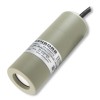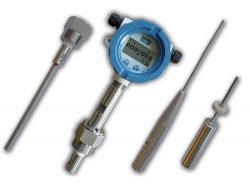 Measurement and point detection devices for monitoring liquid level and activating switch contacts at predetermined liquid level thresholds.
Measurement and point detection devices for monitoring liquid level and activating switch contacts at predetermined liquid level thresholds.
A liquid level switch is an instrument for monitoring the height of a liquid and tripping a relay contact switch or transmitting a solid state relay switch output when a maximum, minimum or intermediate level has been reached. The liquid level switch output can then be utilised by other instrumentation to open a valve, illuminate an warning lamp, activate an audible alarm, or switch on/off a pump.
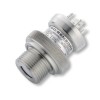 0-10 Volts Output Hydrostatic Sensors, Probes & Transducers
0-10 Volts Output Hydrostatic Sensors, Probes & Transducers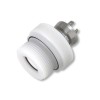 External Mounted Tank Level Sensors
External Mounted Tank Level Sensors 4-20mA Output Hydrostatic Level Transmitters & Sensors
4-20mA Output Hydrostatic Level Transmitters & Sensors Hydrostatic Level Sensors
Hydrostatic Level Sensors
There are two basic types of liquid level switches, those that detect the presence of liquid known as point level detection, and those that are continuously monitoring the variation in level to detect when a threshold has been reached.
Point level switches have to be mounted so that the sensing probe makes contact with the fluid. They are simpler to set-up and calibrate, since the installation position dictates the switch point, however this also limits where the point level sensor can be installed.
There are many applications on a liquid storage tank where a switch provides a lower cost and simpler installation for managing tank contents because there is no need for additional signal conditioning instrumentation, and some switch types are mechanically activated and require no electrical supply or electronic circuits to function.
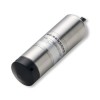 Protecting low range river level sensor from storm surges
Protecting low range river level sensor from storm surges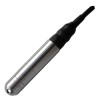 2.5 metre water level transmitter for submersing inside underground tank
2.5 metre water level transmitter for submersing inside underground tank 4 metre range submersible freshwater level transmitter
4 metre range submersible freshwater level transmitter Harbour seawater level sensor with digital display & relay outputs
Harbour seawater level sensor with digital display & relay outputs
Product Type Comparison Table
Please use the table below to compare the advantages and disadvantages of each liquid level switch technology type versus application and specification parameters.
| float | conductivity | capacitive | hydrostatic | tuning fork | ultrasonic | |
|---|---|---|---|---|---|---|
| media contact | yes | yes | yes | yes | yes | no |
| moving parts | yes | no | no | yes | yes | no |
| surface disturbance sensitive |
no | no | no | no | no | yes |
| pressurised vessel | yes, low pressures | yes | yes | more difficult | yes | yes |
| vacuum evacuated vessel | yes | yes | yes | more difficult | yes | no |
| installation position | top, side, bottom | top, side, bottom | top | side, bottom | top, side, bottom | top, side |
| thick fluids | no | no | no | yes with flush diaphragm | no | yes |
| protrusion into tank | yes | yes | yes | no | yes | no |
| sg density variation sensitive | no | no | yes | yes | yes | no |
| fouling degrades performance | yes | yes | yes | yes | yes | no |
| multiple point level detection | vertical entry yes, side entry no | vertical entry yes, side entry no | yes | yes | vertical entry yes, side entry no | top entry yes, side entry no |
| accuracy | low | low | low | high | high | high |
| cost | low | low | high | high | high | high |
| power supply required | no | yes | yes | yes | yes | yes |
 High temperature water level transmitter for measuring up to 1 mWG
High temperature water level transmitter for measuring up to 1 mWG Aquaculture submersible freshwater level & temperature transmitter
Aquaculture submersible freshwater level & temperature transmitter 1 bar submersible water depth sensor with 4 to 20mA output
1 bar submersible water depth sensor with 4 to 20mA output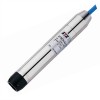 0 to 5 volt output sensor for measuring low seawater level
0 to 5 volt output sensor for measuring low seawater level
Related Help Guides
- Measuring liquid level in a tank using a dp sensor
- Measuring liquid level in a sealed tank with a hydrostatic pressure sensor
- Using a screw-in or waterproof pressure transmitter to measure liquid level
- How to determine milk tank level and volume from pressure
- Measuring the volume of liquid in a horizontal cylinder tank
- How do you measure the volume of a liquid using pressure
- Improve the electrical termination of vented submersible pressure sensors
- Difference between vented and non-vented water level measurement
- Determining water tank volume using hydrostatic pressure
- Calculating required pressure range for fuel tank level measurement
- Using absolute pressure sensors to measure hydrostatic level
- Determining the hydrostatic pressure range for a tank level sensor
- How does changes in Local Gravity affect Hydrostatic Pressure
- Considerations for monitoring Landfill Water Level
- Why are Submersible applications so demanding of Pressure Transducers?
- Determining the Signal Cable Length of a Suspended Liquid Level Transducer
- Are all IP68 Water Resistant Protection Ratings the same
- Converting non-vented depth readings & barometric pressure to true depth
- Liquid Level Measurement
Related Technical Terms
- Capacitive Fluid Level Measurement
- cmH2O – Centimetres of Water Column at 4 deg C Pressure Unit
- Conductive Fluid Level Detection
- Float Fluid Level Detection
- ftH2O – Feet of Water Column at 4 deg C Pressure Unit
- mH2O – Metres of Water Gauge at 4 deg C Pressure Unit
- mmH2O – Millimetres of Water Column at 4 deg C Pressure Unit
- Specific Gravity
- Vibrating Tuning Fork Fluid Level Detection
Related Online Tools
- Fluid Depth, Density, Gravity, and Pressure Calculator
- Liquid Level to Hydrostatic Pressure Calculator
- Liquid Level Transmitter 4-20mA Current Output Calculator
- Vertical Cylindrical Shaped Tank Contents Calculator
- Horizontal Cylindrical Shaped Tank Contents Calculator
- Rectangular Shaped Tank Contents Calculator


